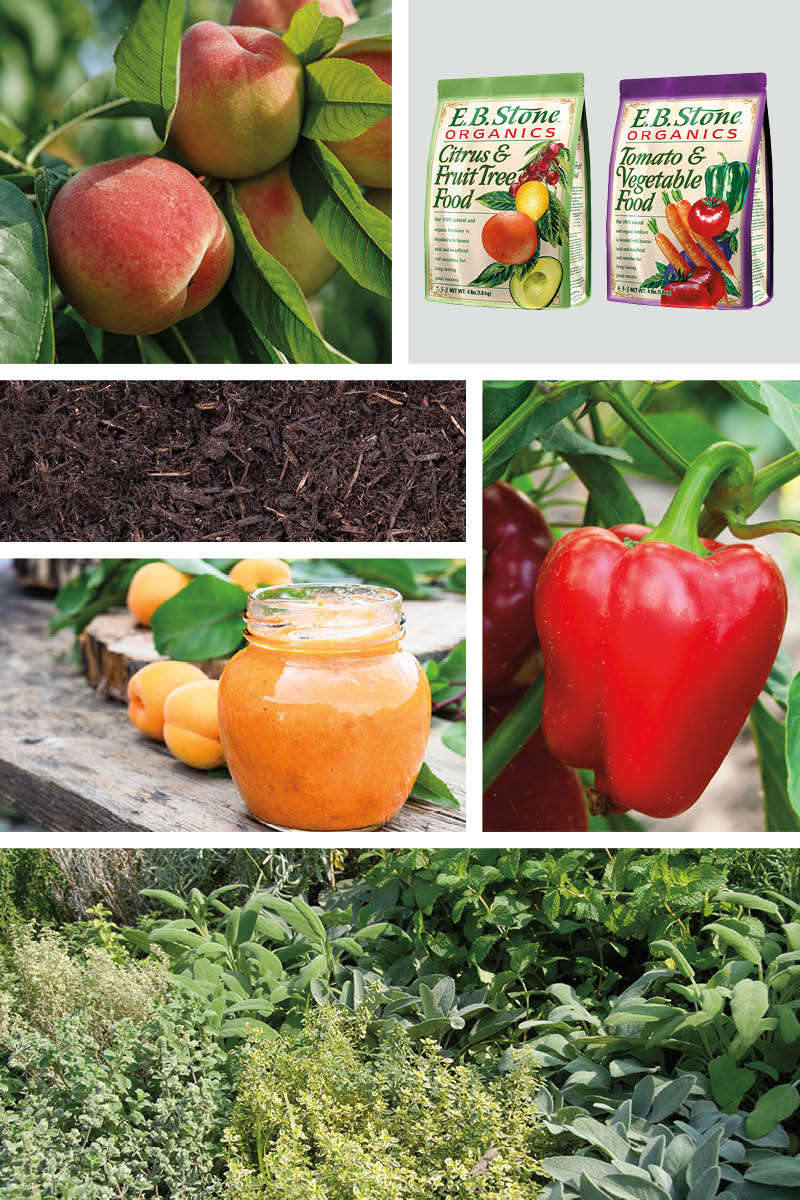
Summer Series II, Healthy Harvest

It's Harvest Time!
You’ve put in the work, now it’s time to reap the rewards of a job well done. If your fruit trees and veggie garden are thriving and delivering a good harvest—you’ve definitely done something right this season. Let’s keep the bounty coming with some care tips from our garden gurus.
Keep On Producing
FRUIT TREES
- Water: Be sure the water is getting to the roots, especially during the hot summer months. Drip irrigation, at the right rate and time, provides deep root watering—if you’re only using a sprinkler or hose, you may not be getting water to the roots.
- Feed: It’s not too late! We recommend fertilizing four times per year with an organic fertilize that has a nitrogen level of seven to eight or lower. Try E.B. Stone™ Organics Citrus & Fruit Tree Food.
- Prune: Generally, it’s okay to do some light pruning this time of year to control height, remove dead or diseased wood and suckers, and increase air flow. However, we don’t recommend any heavy pruning—or you may expose your tree to sunburn. Save the hard pruning for the winter season when the tree is dormant.
- Mulch is a powerhouse that provides for your plants’ long term health and vigor. Mulch protects root zones, slows the evaporation of water, and suppresses weeds.
- Harvest: Nothing compares to picking a tree-ripened peach or apricot or plum from your own tree. The taste is incredible! Look for fruit that has good size, good color, and is firm-ripe to the touch. Now, twist and pull.
VEGGIES & HERBS
- Water: It’s summer, temps are high, and your plants are thirsty. Sometimes we find that our plants and soil are thirsty nearly every day, and thirsty plants can result in low fruit and flower yields. To make sure your plants are getting the right amount of water, consider drip soaker tubing, which is easy to use and frees you from having to add or replace drip emitters, all while providing efficient water savings and a clean, tidy look.
- Feed: Everything in your edible garden is hard at work right now. Rely on organic fertilizers every four weeks or so to feed the soil and keep veggies producing at top speed. We recommend feeding every four weeks with E.B. Stone™ Organics Tomato & Vegetable Food. Also great for soft fruits like strawberries.
- Prune: To prune or not to prune veggies? The short answer is: Maybe. Veggies like tomatoes and peppers don’t need to be pruned, but you can prune at the beginning of the season to shape the plant and create better air flow.
- Mulch: Refresh or add mulch to protect roots and keep them cool. We like G&B Organics Soil Building Conditioner because it adds nutrients back into the soil.
- Harvest: One of the benefits of having your own veggie garden is that you can let the fruit ripen on the vine. Fresh and delicious. Look for even color, or give them the tried-and-true taste test. For herbs, harvest the tops to promote new growth and create a bushy, well-rounded plant.

Enough Already!
If you have more fruits and veggies than you can use or give away to friends and neighbors, you should try the process of preserving. Preserving food will allow you to continue enjoying the flavors from the orchard and garden well into the winter months. These go-to methods are well-known and most are easy. They include canning, drying, and freezing.
Canning
Canning
Canning, also known as jarring, has been used throughout generations to preserve food without having to freeze it. Both fruits and vegetables are great canning candidates.
Foods from the garden that can be used in hot water canning: strawberries, blueberries, blackberries, raspberries, peaches, plums, nectarines, pickled veggies, cucumbers, and tomatoes.
Drying
Foods from the garden that can be used in hot water canning: strawberries, blueberries, blackberries, raspberries, peaches, plums, nectarines, pickled veggies, cucumbers, and tomatoes.
Drying
Drying, also referred to as dehydrating, is a great way to preserve fruits and vegetable, and one of the least expensive forms of food preservation. Dried fruits and vegetables can be consumed raw, cooked, or even blended into powders. The average shelf life for dried fruits and vegetables is one to three years.
Foods from the garden that are great for drying: apricots, strawberries, blueberries, plums, grapes, corn, green beans, tomatoes, and peppers.
Freezing
Foods from the garden that are great for drying: apricots, strawberries, blueberries, plums, grapes, corn, green beans, tomatoes, and peppers.
Freezing
Freezing is an effortless way to preserve your favorite foods year-round. Freeze any extra fruits and veggies for use at a later time. During the cold months of winter, you will be glad you did!
Foods from the garden that are great for drying: strawberries, blueberries, raspberries, peaches, corn, cucumbers, zucchini, squash, green beans, and peas.
Foods from the garden that are great for drying: strawberries, blueberries, raspberries, peaches, corn, cucumbers, zucchini, squash, green beans, and peas.
